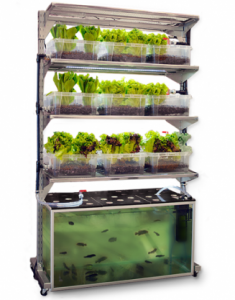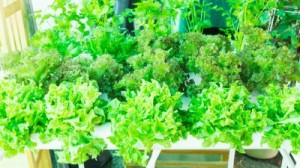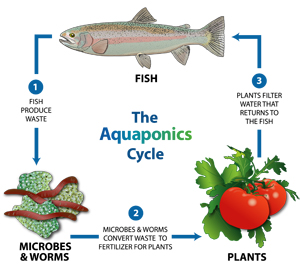Food, one of the very basic necessities of life, is not always so readily available around the world. With the constant growth of the global population and scarcity of resources, it has become necessary to grow more food using processes that utilize all available resources to the fullest, in the most efficient way. Growing more food has also become necessary in both developing countries and developed countries around the world, due to increasing prices and living expenses. For addressing the growing demand for food, aquaponics can become one of the most efficient ways to produce food, and the answer to global food crisis.
Potentially, aquaculture can provide high quantities of food supplies around the globe in a sustainable manner, without negatively impacting the globe. One of the greatest things about aquaponics is that it can be done at any scale, so it can be easily setup in the backyard, basement or in the kitchen. A small-scale aquaponic system can be setup anywhere, and doesn’t need a lot of effort or money to get it going.
What is aquaponics?
 Are you wondering what aquapanics is? Well, the easiest way to describe aquaponics is that it is a combination of aquaculture or raising fish and organic hydroponics, which is the growing of plants without soil. Aquaponics does both, it raises fish and grows plants at the same time, in one integrated system. So you are able to use the waste from your fish as food for your plants. When the water is circulated through the system, plants absorb the ammonia and nitrogen-based waste, which are poisonous for the fish but good for the plants. The water then becomes clean and poured back into the fish tank with the help of a pump.
Are you wondering what aquapanics is? Well, the easiest way to describe aquaponics is that it is a combination of aquaculture or raising fish and organic hydroponics, which is the growing of plants without soil. Aquaponics does both, it raises fish and grows plants at the same time, in one integrated system. So you are able to use the waste from your fish as food for your plants. When the water is circulated through the system, plants absorb the ammonia and nitrogen-based waste, which are poisonous for the fish but good for the plants. The water then becomes clean and poured back into the fish tank with the help of a pump.
The presence of nitrifying bacteria and composting worms also play an important role in this process, as these germs and composting worms act as nitrogen converters. They covert ammonia from the fish waste first into nitrites, then nitrates and the solids into vermicompost that are food for the plants.
Usually a wide variety of fresh water fish, such as tilapia, koi, trout, gold fish, and catfish can be used. You can grow a wide variety of plants as well in this system. This process does not need additional fertilizers or nutrients for the plants and you can use all organic, all natural products to run this system, so it is environmentally friendly.
How it is different from traditional soil-based farming?
 The first benefit that you can clearly see in this system is that you are getting two types of food at the same time. You also do not have to worry about weed and fertilizers, or soil-borne insects for the plants. Generally, aquaponic systems require less water and resources and can produce more food in a shorter amount of time. The best part is, it can be set up in any place pretty easily at any scale. You don’t need equipment or a plough for digging and it’s relatively easy to do.
The first benefit that you can clearly see in this system is that you are getting two types of food at the same time. You also do not have to worry about weed and fertilizers, or soil-borne insects for the plants. Generally, aquaponic systems require less water and resources and can produce more food in a shorter amount of time. The best part is, it can be set up in any place pretty easily at any scale. You don’t need equipment or a plough for digging and it’s relatively easy to do.
Most of these aquaponic systems do not need any chemicals and can be run with a minimal use of resources, producing maximum outputs. With an indoor system, you can grow your own food all year long, and also produce enough food to start selling and marketing your food for a profit.
What you will need for an aquaponic system
 If you decide to set up an aquaponic system at home, in your backyard, or in a small scale farm, you will need just a few things to get started. For starting a small scale aquaponic system, you can get started with a 3-20 gallon plastic or glass container. A fish tank or aquarium can also be used for keeping your fish. You will need about 10 pounds of gravel, a small water pump of 4 watts, some tubing, electric tape, and an air pump. You may also want to get a pH testing kit. This will make sure that your water doesn’t get too acidic. Then get your fish and plants.
If you decide to set up an aquaponic system at home, in your backyard, or in a small scale farm, you will need just a few things to get started. For starting a small scale aquaponic system, you can get started with a 3-20 gallon plastic or glass container. A fish tank or aquarium can also be used for keeping your fish. You will need about 10 pounds of gravel, a small water pump of 4 watts, some tubing, electric tape, and an air pump. You may also want to get a pH testing kit. This will make sure that your water doesn’t get too acidic. Then get your fish and plants.
Your fish are primarily fed worms and plant based food. You do not need to feed them any other food once you get the system going. You can find step-by-step instructions for setting up an aquaponic system, here.
To learn more about sustainable agriculture and training, please contact our office. Click here to watch our webinar on aquaponics.
Source: Nourish the Planet




i m interested in breeding small scale back yard or farm rainbow trout fish, i would like to be advised if trout fish can be breed in Botswana. where can i get fish training short courses for guidance